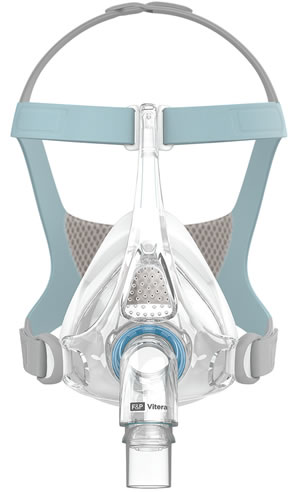Product Spotlight
The F&P Vitera: Rolling With the Changes
Fisher & Paykel Healthcare's new full-face offering focuses on ensuring optimal fit regardless of how patients change their sleeping position during the night.
- By David Kopf
- Dec 01, 2019
No two sleep therapy patients sleep the same way —
they roll over, they fidget, they flip, they flop, they throw off the covers — and
somehow their CPAP mask is supposed to stay in place so that it can continue
to deliver optimal therapy throughout the night. That’s the tricky challenge all
mask manufacturers face, and it’s the underlying philosophy behind Fisher & Paykel’s new Vitera full-face CPAP mask. With this recently unveiled offering,
Fisher & Paykel Healthcare sought to create a mask that moves with patients
and adapts to their ever-changing sleeping positions.

A key feature of the new Vitera
is its RollFit XT mask seal, an
upgrade on Fisher & Paykel
Healthcare’s original RollFit that
is nearly twice as effective at
moving with patients than its
predecessor.
The Vitera shares some common DNA with its predecessor, the F&P
Simplus full-face mask, but every single component on the new mask has been
redesigned, according to Matt Caughey, category marketing manager — OSA
product management for the Auckland, New Zealand-headquartered sleep
therapy manufacturer with its U.S. office in Irvine, Calif. The driving force
behind this new offering, the Vitera, comes down to performance.
“We needed a mask that can perform really well,” Caughey says. “We’ve
done quite a bit of research, and still leaks with full face masks are an issue,
and particularly with full face masks, which are used at high pressures. Fundamentally we need to deliver a mask that, first and foremost, doesn’t leak,
delivers the best therapy, and then secondly is comfortable. It’s a mask that
redefines performance.”
In fact, leaks are an agonizingly all-too-common problem with full-face
masks, according to Caughey.
“We’ve done some online research and what we found that one in three fullfaced
users who’ve reviewed the product online, mentioned leak as a problem,”
he explains. “So leaks still are an issue. If you have a mask that’s leaking, it’s
not delivering therapy for patients.”
Fisher & Paykel Healthcare wanted a mask that truly performs. So, starting
a number of years ago, F&P began investigating how it could perfect a full-face
mask. The company had a successful and well-received mask with the Simplus
and used that as a starting point to see how it could optimize every element of
a full-face mask.
KEY FEATURE: ROLLFIT XT
One of the primary features that helps the Vitera adapt to patients moving as
they sleep is Fisher & Paykel Healthcare’s new RollFit XT. As mentioned, sleep
therapy patients move around in bed, and their mask has to move with them.
F&P designed its RollFit mask seal to move with patients, but the Vitera’s RollFit
XT takes it to the next level, moving 93 percent more than its predecessor.
“The benefits of that are twofold really,” Caughey says. “It relieves pressure
on the bridge of the nose. Secondarily it adapts to the face, as patients
move during the night, as they do. Then we’ve spent a lot of time on the
seal, optimizing it to minimize leaks. We’ve added the seal, we’ve added in
silicon at various parts of the seal to make it more durable and more robust
to minimize blowout.”
How did Fisher & Paykel Healthcare make a good thing better when it
comes to the RollFit evolution into the RollFit XT? Patient comments were key,
according to Caughey. RollFit has been around for a while, and F&P began
collecting feedback on how the company could take it to the next level as it
aimed to evolve its full-face offering from the Simplus to the Vitera. That feedback
resulted in F&P optimizing every size of seal for the patient demographic.
For instance, the small is now smaller, and the large is now larger.
OTHER INNOVATIONS
In addition to RollFit XT, the Vitera features a new stability bar that anchors
the mask on the forehead and provides stability for the RollFit XT seal to
work. This helps to address the challenge of full-face masks being operated
at high pressures and needing to make a seal while users move around in
bed.“Research shows 25 percent of people are restless sleepers,” Caughey
says. “So we think the combination of a stability bar and the seal provides the
best kind of stability and leak performance for the patient. Those two things
together deliver what we call dynamic support technology.”
Another improvement to the stability bar is that it is narrower to deliver a
clear line of sight. This helps make the full-face mask even less obtrusive.
Also featured on the Vitera is Fisher & Paykel’s VentiCool fabric, which
dissipates moisture and heat.
“This fabric is something like what you might find on your sport shoes,”
Caughey says. “CPAP patients are not only taking in warm, humidified air,
some of them sleep in warmer environments, and some larger patients as well
have issues with the sweat. So we’ve incorporated this into the mask. Also, it’s
very light and dries really easily.”
The Vitera is currently available to sleep therapy providers and their
patients.
Vitera
Fisher & Paykel Healthcare
(877) 707-5454
www.fphcare.com
This article originally appeared in the Nov/Dec 2019 issue of HME Business.
About the Author
David Kopf is the Publisher HME Business, DME Pharmacy and Mobility Management magazines. He was Executive Editor of HME Business and DME Pharmacy from 2008 to 2023. Follow him on LinkedIn at linkedin.com/in/dkopf/ and on Twitter at @postacutenews.